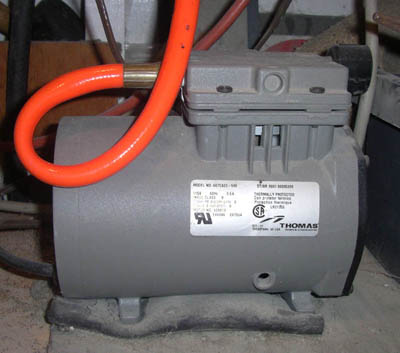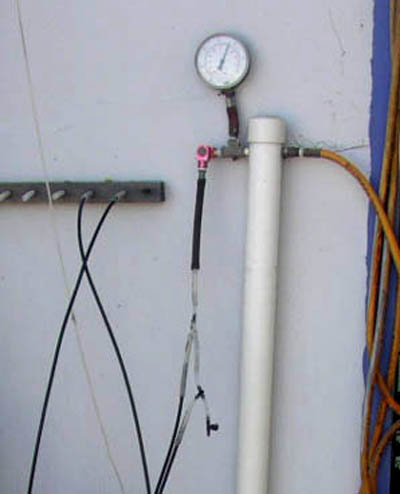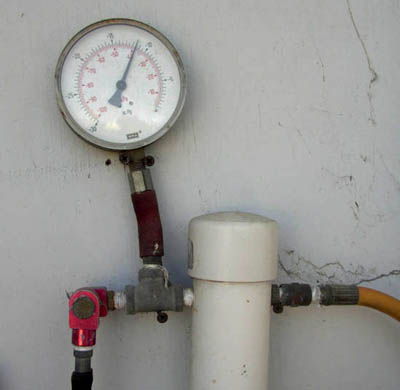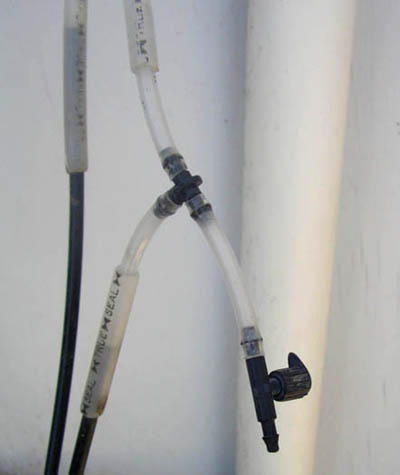|
| |
| Vacuum System |
|
| the heart of the shop |
|
| To reliably affix sheet foam to
boards and to evacuate water, there is nothing more efficient or more
convenient than a vacuum system. Its a set-and-forget-it proposition and
- once you have gotten the knack of it - you will wonder how you ever
did without. The bits and pieces making up the system are easily cludged
together from hardware store items and need not be expensive.
At the core, obviously, is the pump: it need not be
a fancy rotary one, a modest piston type will do; it need not be capable
of a "deep vacuum", since most boards will fall over dead in anything
over about 1/2 of a "deep vacuum", anyway; it does not need to be
2-stage; it does not need to pull more than about 3cfm (cubic feet per
minute), since - once set up and drawing - it needs to simply be able
and keep up with the niggely leaks inherent in a system.
Good sources for inexpensive vacuum pumps are
ebay and industrial recyclers.
|
| My favorite pump is a Thomas with about 1/10HP
drawing 3.5cfm. They faithfully put-put away in the background 10hrs a
day/7 days a week, until somewhere after 4 or 5 years, they clonk
briefly and then give up the ghost. Autopsies invariably reveal
inhalation of salts and resins. Ooops. At
about $150.- a piece, I surely feel I am getting my money's worth, speak
some kind words over the corpse, and purchase a new one through ebay.
Onwards! |
 |
| 100ft of air hose are draped hither and yon,
eventually connecting the pump to a standpipe, a heavy-wall bit of PVC
tubing. To assure that salts and resin fumes not easily make it past
standpipe and into pump, I glued a baffle plate into the top half of the
pipe, separating the intake from the outlet side.
Regular air fittings are threaded into the sides of
the pipe to facilitate hook-up with the associated plumbing. |
 |
| To assure safe operating levels, and to be able
to quantify leaks, I most highly recommend use of a vacuum gage.
Suppliers to the HVAC industry carry a variety of such gages - for
myself, I prefer a large analog dial, so I can see across the shop just
when I have found that annoying leak in the bag. |
 |
| Branching off from the main line are a multitude
of smaller hoses, each going to a different board. I have used up to 6
individual pick-ups simultaneously, before the inherent leaks add up to
more than the pump can handle. At the end
of the manifold, the most important fixture of all: the controlled leak,
with which I adjust the exact level of vacuum.
Again, this is not a fancy, approved
vacuum-bagging fixture, but rather, a 99cent valve originally intended
for sprinkler systems. Works like a charm! |
 |
| At the bottom of the standpipe, a valve, to
drain the effluent. Poor thing has to live with lots of salt water, so
looks a little cruddy.... Very satisfying
to get water gushing out of there at the end of the day! |
 |
| Vacuum bagging supplies are a mix of improvised
and "official": the vacuum tape (yellow roll) is so superior as to be a
no-brainer. For film, I use Visquene from the hardware store, instead of
vacuum film at about 5 times the price. Peel ply and breather fabric
don't really have equivalents in the civilian world, so they come from a
vacuum supplier. Hoses are sprinkler tubing from the hardware store. For
the sealing of little leaking tears and such, I like the tacky strips
sold in stationary stores. And those most convenient pick-up cups come
from the good people at West System resin.
Go see the list of suppliers under misc/sources! |
 |
|
return
to miscellaneous |
|